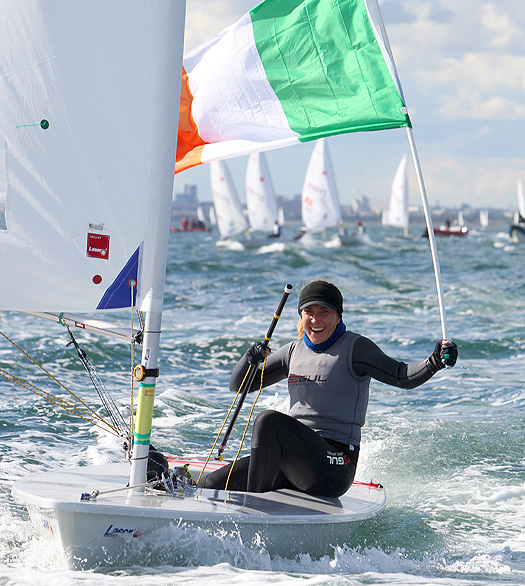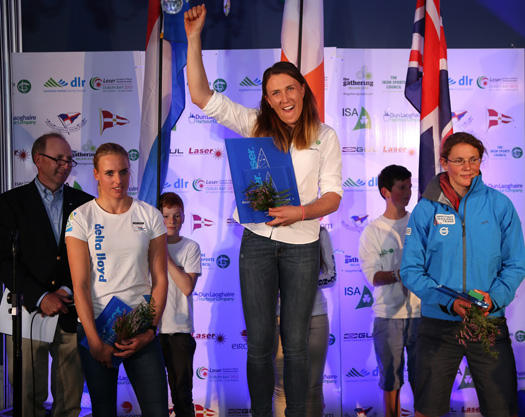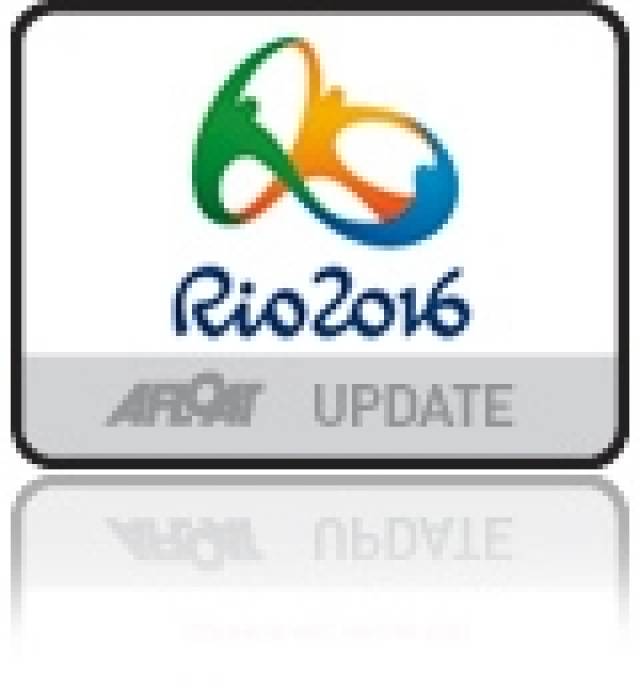#LaserEuro2013 – Ireland's Annalise Murphy is the new Olympic Laser European Champion, winning her first major international trophy urged on by family and supprters on her native Dublin Bay this afternoon. It's a sweet victory on home waters that won't quite make up for missing out on an Olympic medal this time last year but it is all the same a major boost to her Olympic campaign towards Rio 2016.
The Dubliner won an outstanding seven races out of ten in the week long series, a feat seldom seen in top flight Olympic class competition and one that mirrors Weymouth and London 2012 in many ways.
The 23–year–old National Yacht Club sailor finished second, third and first in the final three races this afternoon to win the regatta by some margin.
In the end, a much anticipated final race fight between rivals Murphy and Olympic silver medalist Marit Boumeester of Holland did not materialise. Dun Laoghaire's golden girl took the upperhand from the start of the final race of today's championships, looking very much the winner, beaming with confidence and chatting and joking with fellow competitors between races.
Her many supporters afloat and ashore all knew well how the 23–year–old had lost out an Olympic medal in Weymouth in the closing stage a year previous, so there could be no repeat today on home waters.
With a ten knot wind moderating and a nasty chop on Dublin Bay, Murphy pulled out the stops to lead her 90-boat fleet by 100 metres at the first weather mark. It was a lead she never relinquished, she built a solid lead over Belgium's Evi Van Acker to take the European title in some style.
Immediately after she cleared the finish line, Annalise punched the air, smiling broadly as she was handed an Irish tricolour to wave, sailing home to her National Yacht Club for a hero's welcome. Nearby boats and yachts let off hand flares as an armada of supporting vessels gathered around the winning dinghy helmswoman.

Annalise celebrates her European Radial win in Dun Laoghaire today. Photo: Richard Langdon
Fourth place - the so called leather medal - is always the hardest result to accept for an Olympic athlete. But for both the 2012 Olympic sailors who collected their respective Laser European titles today after a thrilling final day on the sparkling waters off Dun Laoghaire, Ireland, winning the first big championship since they finished fourth in the Laser Olympic regatta marked the first steps on the long road from 2013 Dublin Bay to Rio 2016 on Guanabara Bay, with a key title victory.
For Murphy it was a fairy-tale win, her first ever major Laser title, won on the waters where she learned and trained as a youngster and the same sea to which she returned to the Laser in the freezing cold of last November, her first time back in the boat since the bitter disappointment of losing an Olympic medal on the last race. Murphy had lead overall after the first two days of her first Olympic regatta, winning four races in succession and went in to the Medal Race finale as one of four girls who were only one point apart.
Just over a year ago Murphy proved to be the one who finished empty handed and disappointed in but as she triumphantly topped out the European Championship standings today, with eight wins from 12 starts, she left Holland's 2012 silver medallist Marit Bowmeester in her wake as runner up, a conclusive 22 points behind, and Belgium's bronze medallist Evi van Acker 31 points adrift. Britain's Alison Young took third overall.
Murphy was carried up the slip of the National Yacht Club shoulder high by her fellow Irish sailors still in her Laser, smiling broadly. "It was pretty tough after the Olympics. It hurt to have finished fourth, especially to have been in a medal position all the way through. It made me train pretty hard this year, I have been pretty focused these last few months and I knew I had a goal here. I was not too sure how everyone else was going to perform. I am so delighted."

Annalise (centre) celebrates her trophy win with father Con looking on and Marit Boumeester (left) second and Alison Young third. Photo: Richard Langdon
"It is so special to win here at my home club. My mum and dad are here, my sister is here. It is awesome, it is great to see all the club members here sharing it with me. They have been such a huge support for me over the last two years. It is great. Rio is still three years away. I have a lot of training to do and a lot of racing, But this feels great to win my first big event."
"I have not done any more or less training here or before Weymouth. I have always done plenty. I have another year's experience. I was extremely nervous after my first two days at the Olympics after winning the first four races. But here, after winning so many races, I did not have that same nervous feeling, because I knew what not to do. I was a bit apprehensive today but mostly I want to just prove I could go out and have another good day."
In the Men's Laser Radial fleet Australia's Tristan Brown retained the World title despite a shaky final day. Brown, from Fremantle, WA, is a regular training partner for Marit Bouwmeester who he has worked with since two years before she won the Women's Radial World 2011 title. Poland's three times World Champion Marcin Rudawski pipped 17 year old local ace Finn Lynch, who won silver at last year's ISAF Youth World Championships, to win the European Men's Radial championship.
But Ireland's Finn Lynch didn't fare too badly either. The 17 year old from Bennekerry, Co. Carlow is the 2013 U21 Men's Laser Radial World Champion. He also won Bronze in the overall World Championship and Silver in the European Championship. The ISA Academy teenager sailed consistently throughout the 12 regatta races notching up nine top 5 finishes including two race wins.
Croatia's Tonci Stipanovic secured the Laser Men's European title for the third time, following wins in 2010 and 2011. But it was only within the final 500 metres of the last race that he took the one place that ensured the championship and the European Trophy were both his. In the closest finish to the hardest fought Laser European Championship for many years, the sailor from Split emerged one point ahead of Brazil's five times Olympic medallist and eight times World Champion Robert Scheidt in the European Trophy, and had just two points in hand over Holland's Rutger van Schaardenburg.
After a full diet of 12 races on Dublin Bay in a broad range of conditions, from 5 to 20 knots and most directions of the compass, only five points separated Stipanovic from Great Britain's Nick Thompson who started the final day with a two points lead but finished fifth overall. On Weymouth & Portland's notorious Medal Race arena 14 months ago Stipanovic rounded the final gate in bronze medal position but rather than cover, he tacked away from Sweden's Rasmus Myrgren who worked ahead to steal the medal.
The doughty Croat gave himself just a month off from training and has worked tirelessly since. Murphy took time away from the Laser after the 2012 Games but retained her fitness with competitive triathlon and iron-man events. As respective rewards for their European victories Murphy was due to treat herself to a '99' cone from legendary local ice-cream Teddy's of Dun Laoghaire maker while Stipanovic was relishing to seven days at home, looking forwards to long walks with his beloved dog.
Stipanovic, World Championships runner up last year in Boltenhagen, Germany returned to the boat park this afternoon dazed but delighted, confirming this was significantly harder than his previous European titles. "This was the hardest because when it was not going good I was pushing, pushing. No one could say I was lucky."
"I am sailing better than this time last year. I am fitter and stronger for the strong winds when I am feeling more comfortable."
"It was so hard today. I was trying to do the best I could. On the first upwind mark it was not looking good I was 31st and managed to finish eighth. So I was leading by one point. The second race we were all close but I lost the wind pressure downwind and they all passed me. Then I knew I had to push more. In the end I finished sixth. That was enough. It was so hard."
Of his fourth place at last year's Olympic Games, he said "The Olympics finished last year and that is it. And the door is closed. Now it is a new road to Rio. I don't think about the Olympics, what happened. I had very little time off because I did not do my job properly, so I had to train more and not to rest. So I started working almost immediately to be better for Rio."
Robert Scheidt, back in the Laser after a seven years gap, proved he is close to his championship winning best. Two weighty scores in the four Finals races meant Scheidt counted a 23rd in his 46 pts final aggregate. Otherwise he never finished worse than fourth and lead overall into the final race. "Overall I am happy to finish second" Scheidt said, "I had two big scores in this regatta a 24th and a 23rd, so to end up second is a good result. But overall it was a great regatta, testing all the skills strong medium and light winds, current, very high level competitors. I am glad to have come here. And for me the main thing is my performance not necessarily the result."
Rutger van Schaardenburg missed the European title by two points but Holland's Laser sailors finish runners up in both Men's and Women's Olympic classes. He said "I am really happy with my second in the last race and in fact my end result as well, but two points from being European champion is pretty hard to take at this moment. That is really hard, you start to think about those races which went before, maybe the odd point here and there you could have gained. But, then, that is what makes the difference between being champion and runner up. I am really pleased, but when it is that close it is hard."
Poland's three times World Champion Marcin Rudawski pipped 17 year old local ace Finn Lynch, who won silver at last year's ISAF Youth World Championships, to win the European Men's Radial championship.
See www.lasereuropeans2013.com for full results.
































































